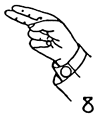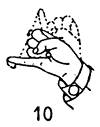|
 In Part One, "Revolution of the Word," the basic issue is one of freedom of letters versus their "subservience to correct speech and proper spelling" and proper placement on a page. It moves from Mallarmé through the futurisms, Stein's rhythmic free associations to William's "As birds' wings beat the solid air without which none could fly so words freed by the imagination affirm reality by their flight." Also included here is work from contributors to Eugene Jolas' transition, such as Finnegans Wake and Bob Brown's "The Readies". In Part One, "Revolution of the Word," the basic issue is one of freedom of letters versus their "subservience to correct speech and proper spelling" and proper placement on a page. It moves from Mallarmé through the futurisms, Stein's rhythmic free associations to William's "As birds' wings beat the solid air without which none could fly so words freed by the imagination affirm reality by their flight." Also included here is work from contributors to Eugene Jolas' transition, such as Finnegans Wake and Bob Brown's "The Readies".
 Part Two, "Oralities, Rituals, and Colloquies," addresses the "in-group" and the richness of out-group languages, sound dimensions, conversations with divinities and aliens, and fictive encounters. It includes languages of communities which range from Canting to Whitman's "Slang in America" to finger alphabets and chirologia. Sound effects contains items such as a piece of The Birds, a part of Schwitters' Sonata in Urlauten, Charles Callet on Hissing and Bellowing and Oulipo's alphabetic sound exercise. Divinities and Aliens has angels, Martians, glossolalia, and The Lord's Prayer in Formosan. In Fictive Encounters we meet Gargantua, Carroll's Stanza of English Poetry, a tablet from Schwerner and from Schafer, and Riddell's "H" trapped in his own prose. Part Two, "Oralities, Rituals, and Colloquies," addresses the "in-group" and the richness of out-group languages, sound dimensions, conversations with divinities and aliens, and fictive encounters. It includes languages of communities which range from Canting to Whitman's "Slang in America" to finger alphabets and chirologia. Sound effects contains items such as a piece of The Birds, a part of Schwitters' Sonata in Urlauten, Charles Callet on Hissing and Bellowing and Oulipo's alphabetic sound exercise. Divinities and Aliens has angels, Martians, glossolalia, and The Lord's Prayer in Formosan. In Fictive Encounters we meet Gargantua, Carroll's Stanza of English Poetry, a tablet from Schwerner and from Schafer, and Riddell's "H" trapped in his own prose.
 Part Three, "Lost and Found in Translation," covers translation in an extended sense, as in translation of lip poems, schizophrenic language, and "Writing by Invented Characters". Here we find universal languages, cryptography, and transpositions of spoken languages into visual and musical units. Part Three, "Lost and Found in Translation," covers translation in an extended sense, as in translation of lip poems, schizophrenic language, and "Writing by Invented Characters". Here we find universal languages, cryptography, and transpositions of spoken languages into visual and musical units.
 Part Four, "Letters to Words," includes the names of Gods as well as alphabets leading to God in cosmologies where "it is as if a textual potential, and ability to organize the sky as a script, recovers the extraterrestrial for human comprehension." We find here Kamensky's "Lecture on Word creation" and Khlebnikov's "Checklist: The Alphabet of the Mind" rather than just a the usual passing reference to zaum. Alphabetic Dimensions includes, among other exemplars, Hugo's hieroglyphic alphabet, Benjamin Paul Blood's practical alphabet, and bp Nichol's "Probable Systems 14: Re-discovery of the 22 Letter Alphabet: An Archaeological Report." Spelling, Saving, Spending covers writer-reformers from Lucian to George Bernard Shaw, with stops along the way at such creations as Alexander Mellville Bell's Visible Language and John Wilkins' Somatic Production of Sounds where "words are what the mouth molds, not what the mind conceives." Part Four, "Letters to Words," includes the names of Gods as well as alphabets leading to God in cosmologies where "it is as if a textual potential, and ability to organize the sky as a script, recovers the extraterrestrial for human comprehension." We find here Kamensky's "Lecture on Word creation" and Khlebnikov's "Checklist: The Alphabet of the Mind" rather than just a the usual passing reference to zaum. Alphabetic Dimensions includes, among other exemplars, Hugo's hieroglyphic alphabet, Benjamin Paul Blood's practical alphabet, and bp Nichol's "Probable Systems 14: Re-discovery of the 22 Letter Alphabet: An Archaeological Report." Spelling, Saving, Spending covers writer-reformers from Lucian to George Bernard Shaw, with stops along the way at such creations as Alexander Mellville Bell's Visible Language and John Wilkins' Somatic Production of Sounds where "words are what the mouth molds, not what the mind conceives."

Part Five, "Matter and Atom," takes on, among other things, the potential autonomous action of language and language as organic and/or technological growth.
|
|
